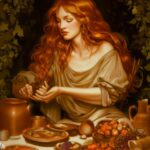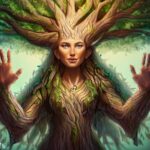The elves believe that in the beginning, the Earth was simply lifeless clay, shrouded in eternal darkness, illuminated only by starlight. For millennia, this was all there was.
Then from the millions of stars in the heavens, thousands of them coalesced to form seven Entities which came down to the earth to give it life. There were seven of them, and the elves would come to call them the Estarine, which translates from Elvish as the Star Children or Star-born.
At first the Estarine were without shape or form or gender: shimmering, undulating clouds of silver, each without gender, or of all genders – simultaneously male and female, both and neither. Then one took shape of a bipedal creature nearly 10 feet tall, virtually hairless save for the top of its head, with skin a pale white with a purplish shimmer. It took the name Ilimoran Toruvial, and its first shape would later become the model for the First Born, who were the elves. Though the Estarine could take the form of any creature, this was the first.
And then the other gods took similar forms: Eldamar Galion, Gathelon Tarminel, Lassamistra Ordymil, Lythia Nuros, Tyra Manora, and Valeria Ithildrim.
Ilimoran fashioned the First Born, the elves, from clay, and infused them with his blood and Tyra Manora’s tears to give them life.
But the world remained barren and lifeless save for the First Born, who drew their sustenance directly from their proximity to the Estarine themselves. Then Tyra Manora rose into the heavens to survey the Earth, and her tears came down in torrents, giving rise to the streams and rivers and seas.
And with her went Lythia Nuros, and the two of them, with the help of the other Estarine, formed a celestial orb known as Lunaal, the largest and first of Adnati’s three moons. And then Ilimoran and Lythia guided the others to harness the power of the stars to create the fiery orb known as Sola, the Sun.
Eldamar Galion submerged himself into the earth to spread rivers of metals and ore throughout, rivers that would later be broken into shards through the earth’s turbulence. And then Eldamar and the other Estarine sprinkled gems and minerals throughout the earth.
And when that was done, Valeria Ithildrim stood on the Earth, and her toes dug into the clay and took root, and her fingers stretched to the heavens and blossomed, and she took form as a mighty oak. Her roots stretched throughout the land, bringing life from the stars, and the other Estarine, with the help of the First Born, gave shape to this life in many forms, the flora and fauna of the land. Some of these, like the humans, dwarves, and gnomes, were also intelligent like the First Born. But the elves were first, and the First Born were tasked with being shepherds and caretakers of all this life.
Nephilim & Anakim Wars
 For a time, the Estarine dwelled with the First Born, taking care of the land with the help of the First Born much like how a shepherd uses the help of sheep dogs. But they were not to be left in peace. In time, more came from the stars, though they were different than the Estarine. They roamed the earth freely, mostly peacefully but some itching for trouble.
For a time, the Estarine dwelled with the First Born, taking care of the land with the help of the First Born much like how a shepherd uses the help of sheep dogs. But they were not to be left in peace. In time, more came from the stars, though they were different than the Estarine. They roamed the earth freely, mostly peacefully but some itching for trouble.
Occasional confrontation came from the Nephilim, great giants from the stars who skirmished on occasion with the First Born. But it was the demon Asha who caused the most trouble, slithering among the First Born and whispering her lies. Some of the First Born broke with their people to side with her, some out of greed and avarice, eager for the riches and power she promised, and others out of fear of the retribution she vowed against all who opposed her.
She secretly stole some of the children of the First Born who allied with her, and with her venom turned them into twisted, evil creatures of the Underdark that the Estarine never imagine. For Asha could not create, as she was weaker than any of the Estarine, but she could corrupt.
In time, Asha persuaded many to join her in rising up against the Estarine, and all of Ilimoran’s efforts to negotiate a diplomatic solution came to naught. Much blood was shed before she faced off against Ilimoran Toruvial on the field of combat. For three days and nights they faced each other alone in single combat before Ilimoran grievously wounded Asha and drove her from the earth and back to the stars. It is said that from the earth where her spilled blood mingled with Ilimoran’s, the medusas were born.
With their leader gone, the First Born who had allied with Asha fled and disappeared into underground lairs, and the Nephilim threw down their arms and sued for peace.
The Withdrawal
The Estarine came to realize that further dangers could come from the stars if they did not protect their creation. They chose to withdraw to the heavens, barring the gates behind them, leaving behind only Valeria Ithildrim, who chose to remain planted in the earth. From the heavens, they would still have influence on the earth, but from afar and more limited.
Before they left, they gave gifts to the First Born who would remain caretakers of their creation.
Ilimoran Toruvial gave them fire and taught them its uses. He taught them how to hunt and how to engage in individual combat. He taught them how to compose and perform great sagas to share their history and gave them a written language to record it. Ilimoran also taught them the greater arcane arts.
Eldamar Galion taught the elves how to work the metals of the earth to create tools and weapons and feats of engineering. He taught them how to sculpt from clay and how to chisel statuary and other works of art from solid stone.
Lassamistra Ordymil gave the gift of agriculture, livestock husbandry, and culinary arts.
Lythia Nuros gave them rules of governance and the codification of laws, while Gathelon Tarminel gave them due process and protection of individual rights.
Tyra Manora taught them the ways of the water: sailing, fishing, and using water for cunning inventions like watermills, while Valeria Ithildrim taught them the ways of the forests.
Then the Gods retreated to the stars, creating a veil between the earth and the stars that would prevent other outsiders from interfering with their creation. Some, particularly the Sylvan Elves, believe that Valeria Ithildrim remained behind to protect the earth, while others believe that she too returned to the stars and the Ithildrim are her descendants.
The elves believe that the Estarine continue to watch over the earth, though their power to influence is reduced and must be channeled through their worshippers to bypass the restrictions imposed by the Veil.
Description of the Gods
The elven gods are depicted as perfectly-formed elves, but taller, usually about 10 feet tall. Each is fairly androgynous-looking, and while they all can and do take the form of either male or female, their appearance only changes minimally when they do. Most are depicted as young adults who appear, in human terms, as if they are in their mid-20s. Each is a patron of different forms of the arts.
Ilimoran Toruvial
 Though the Estarine are considered to be equal in strength and power, Ilimoran is generally presented first in the elven pantheon because of first creating the form to be used by the elves, and because of the three-day single combat against Asha. Ilimoran is depicted as a master hunter who gave bows to the First Born and taught them to hunt. Ilimoran also gave fire to the elves and taught them how to harness it, and also taught them to write, as well as to work magic and record it in scrolls and spell books. Ilimoran is typically portrayed with shoulder-length silver-white hair and pale white skin with a faint purple sheen. He shown as male only slightly more often than female, though most artistic depictions are androgynous enough to be genderless or gender-ambiguous, for Ilimoran is both male and female, both and neither. He is the patron of hunting, fire, greater magic, poetry and storytelling, written history and historical sagas, starlight, and cooperative diplomacy. Domains: Arcana, Grave, Knowledge, Light, Life, Peace, Twilight, War
Though the Estarine are considered to be equal in strength and power, Ilimoran is generally presented first in the elven pantheon because of first creating the form to be used by the elves, and because of the three-day single combat against Asha. Ilimoran is depicted as a master hunter who gave bows to the First Born and taught them to hunt. Ilimoran also gave fire to the elves and taught them how to harness it, and also taught them to write, as well as to work magic and record it in scrolls and spell books. Ilimoran is typically portrayed with shoulder-length silver-white hair and pale white skin with a faint purple sheen. He shown as male only slightly more often than female, though most artistic depictions are androgynous enough to be genderless or gender-ambiguous, for Ilimoran is both male and female, both and neither. He is the patron of hunting, fire, greater magic, poetry and storytelling, written history and historical sagas, starlight, and cooperative diplomacy. Domains: Arcana, Grave, Knowledge, Light, Life, Peace, Twilight, War
Eldamar Galion
 Eldamar is most closely associated with the riches of the earth – as well as the earth’s destructive forces like earthquakes and volcanic eruptions. He taught the elves how to work metals, create tools and weapons, and create engineering marvels including aqueducts and sophisticated sewage systems. He also taught them how to fashion fine arts by blowing glass, sculpting from clay, and chiseling statuary and other works of art from stone. He is generally depicted as male with bronze or copper-colored skin and jet-black hair. He is the patron of armies and of weaponry, of architecture and engineering, and of physical fine arts. Domains: Forge, Knowledge, Nature, Tempest, Twilight, War
Eldamar is most closely associated with the riches of the earth – as well as the earth’s destructive forces like earthquakes and volcanic eruptions. He taught the elves how to work metals, create tools and weapons, and create engineering marvels including aqueducts and sophisticated sewage systems. He also taught them how to fashion fine arts by blowing glass, sculpting from clay, and chiseling statuary and other works of art from stone. He is generally depicted as male with bronze or copper-colored skin and jet-black hair. He is the patron of armies and of weaponry, of architecture and engineering, and of physical fine arts. Domains: Forge, Knowledge, Nature, Tempest, Twilight, War
Gathelon Tarminel
 Of all the Estarine, Gathelon is depicted as the most youthful and the playful. He taught the elves illusions, cantrips, and simple forms of magic, particularly those used for entertainment and amusement. He is a favorite among petty rogues (though not assassins and hardened criminals, who turn to Asha). Many legends show him defending those accused of crimes, believing that everyone deserves a chance to defend themselves and even the guilty should have the opportunity to explain their actions. For this, he is also considered a god “of the people” and the patron of democratic institutions. His hair is depicted as golden yellow, and his skin as alabaster white flecked with golden highlights. He is the patron of instrumental music, democratic institutions, pranks and mischief, toys, wine and other intoxicants, the judicial system, and magic, particularly illusions and cantrips. Domains: Arcana, Knowledge, Peace, Trickery, Twilight
Of all the Estarine, Gathelon is depicted as the most youthful and the playful. He taught the elves illusions, cantrips, and simple forms of magic, particularly those used for entertainment and amusement. He is a favorite among petty rogues (though not assassins and hardened criminals, who turn to Asha). Many legends show him defending those accused of crimes, believing that everyone deserves a chance to defend themselves and even the guilty should have the opportunity to explain their actions. For this, he is also considered a god “of the people” and the patron of democratic institutions. His hair is depicted as golden yellow, and his skin as alabaster white flecked with golden highlights. He is the patron of instrumental music, democratic institutions, pranks and mischief, toys, wine and other intoxicants, the judicial system, and magic, particularly illusions and cantrips. Domains: Arcana, Knowledge, Peace, Trickery, Twilight
Lassamistra Ordymil
 Lassamistra is closely associated with domestic home life, including agriculture, the harvest, and livestock, and of magic that’s more helpful and domestically practical like the mend, light, and mage hand spells, as well as protective abjuration magic. She is also associated with the warm love of an enduring marriage or relationship. She is generally depicted as having auburn hair and brown skin with copper flecks. She is the patron of hearth and home, agriculture, marriage, fertility and motherhood, baking arts, weaving arts like tapestries, and drawing and painting. Halflings have also adopted her into their pantheon. Domains: Arcana, Forge, Grave, Life, Nature, Order, Twilight
Lassamistra is closely associated with domestic home life, including agriculture, the harvest, and livestock, and of magic that’s more helpful and domestically practical like the mend, light, and mage hand spells, as well as protective abjuration magic. She is also associated with the warm love of an enduring marriage or relationship. She is generally depicted as having auburn hair and brown skin with copper flecks. She is the patron of hearth and home, agriculture, marriage, fertility and motherhood, baking arts, weaving arts like tapestries, and drawing and painting. Halflings have also adopted her into their pantheon. Domains: Arcana, Forge, Grave, Life, Nature, Order, Twilight
Lythia Nuros
 Lythia is most associated with the institutions involving elven civilization: governance, politics, international diplomacy, strategic defense, and trade and commerce. She is similarly associated with record-keeping, archives, and libraries, and consequently with academia and scholarship. In both written and performing arts, she is associated with dramatic plays. She is one of the three gods of light and is most commonly associated with the sun. She is associated with ritual magic that can take hours or days to cast, and with arcane lore and the study of lost magic. She is depicted with silver-gray hair, with pale skin flecked with iridescent blue highlights. Domains: Arcana, Knowledge, Light, Peace, Twilight
Lythia is most associated with the institutions involving elven civilization: governance, politics, international diplomacy, strategic defense, and trade and commerce. She is similarly associated with record-keeping, archives, and libraries, and consequently with academia and scholarship. In both written and performing arts, she is associated with dramatic plays. She is one of the three gods of light and is most commonly associated with the sun. She is associated with ritual magic that can take hours or days to cast, and with arcane lore and the study of lost magic. She is depicted with silver-gray hair, with pale skin flecked with iridescent blue highlights. Domains: Arcana, Knowledge, Light, Peace, Twilight
Tyra Manora
 Tyra, who first brought rain to the earth to fill its rivers and seas, is the patron goddess of the weather, of the oceans as well as bodies of fresh water, and of passionate love. She is depicted as being quick to anger but just as quick to forgive and to fall in love. Many young lovers pray to her, as she is the patron of both early romantic love and of uninhibited lust and passion. She taught the elves how to sail, fish, and use the stars for navigation. She is the patron of sailors and fishermen, travelers, lust and passion, moonlight, and dance. She is generally depicted as having green hair and pale aquamarine skin with flecks of blue and green. Domains: Life, Light, Tempest, Twilight, War
Tyra, who first brought rain to the earth to fill its rivers and seas, is the patron goddess of the weather, of the oceans as well as bodies of fresh water, and of passionate love. She is depicted as being quick to anger but just as quick to forgive and to fall in love. Many young lovers pray to her, as she is the patron of both early romantic love and of uninhibited lust and passion. She taught the elves how to sail, fish, and use the stars for navigation. She is the patron of sailors and fishermen, travelers, lust and passion, moonlight, and dance. She is generally depicted as having green hair and pale aquamarine skin with flecks of blue and green. Domains: Life, Light, Tempest, Twilight, War
Valeria Ithildrim
 Valeria Ithildrim, who took root and gave birth to all life, flora and fauna, is in a pantheon already associated with nature understandably the one most closely associated with it. In addition to being the patron of nature and wildlife, she is also the patron of song and of healing. The wood elves always portray her as a mighty oak, sometimes slightly anthropomorphized with knotted wood forming features like an elven woman’s face. High Elves also depict her this way often, but will also depict her as a more heavily anthropomorphized tree, sometimes more tree-like, like a treant, sometimes more humanoid like a dryad. Her more elven-like depictions often show her with dark brown skin and green hair. Domains: Grave, Life, Nature, Twilight
Valeria Ithildrim, who took root and gave birth to all life, flora and fauna, is in a pantheon already associated with nature understandably the one most closely associated with it. In addition to being the patron of nature and wildlife, she is also the patron of song and of healing. The wood elves always portray her as a mighty oak, sometimes slightly anthropomorphized with knotted wood forming features like an elven woman’s face. High Elves also depict her this way often, but will also depict her as a more heavily anthropomorphized tree, sometimes more tree-like, like a treant, sometimes more humanoid like a dryad. Her more elven-like depictions often show her with dark brown skin and green hair. Domains: Grave, Life, Nature, Twilight
Asha
 Though technically not an Estarine, not being one of the original seven, Asha is named in elvish mythology and there are those who continue to worship her. Among the elves, only some drow communities worship her openly. Her worship is forbidden by both High Elves and Wood Elves, and those who revere her do so only in secret cults. She is the patron of assassins, deceit, and treachery. While arrogance is not uncommon among High Elves, those who secretly worship Asha take it a step further, believing that the elves are not only superior to other races but are meant to rule over them and subjugate them as slaves. Those drow believe that she will restore their power and reinstate them in the world above ground. Members of her cults carefully guard the mysteries of her depiction and worship. Domains: Death, Trickery
Though technically not an Estarine, not being one of the original seven, Asha is named in elvish mythology and there are those who continue to worship her. Among the elves, only some drow communities worship her openly. Her worship is forbidden by both High Elves and Wood Elves, and those who revere her do so only in secret cults. She is the patron of assassins, deceit, and treachery. While arrogance is not uncommon among High Elves, those who secretly worship Asha take it a step further, believing that the elves are not only superior to other races but are meant to rule over them and subjugate them as slaves. Those drow believe that she will restore their power and reinstate them in the world above ground. Members of her cults carefully guard the mysteries of her depiction and worship. Domains: Death, Trickery
Domains of the Elven Gods
By God
- Ilimoran Toruvial – Arcana, Grave, Knowledge, Light, Life, Peace, Twilight, War
- Eldamar Galion – Forge, Knowledge, Nature, Tempest, Twilight, War
- Gathelon Tarminel – Arcana, Knowledge, Peace, Trickery, Twilight
- Lassamistra Ordymil – Arcana, Forge, Grave, Life, Nature, Order, Twilight
- Lythia Nuros – Arcana, Knowledge, Light, Peace, Twilight
- Tyra Manora – Life, Light, Tempest, Twilight, War
- Valeria Ithildrim – Grave, Life, Nature, Twilight
- Asha – Death, Trickery
By Domain
- Arcana – Ilimoran Toruvial, Gathelon Tarminel, Lassamistra Ordymil, Lythia Nuros
- Death – Asha
- Forge – Eldamar Galion, Lassamistra Ordymil
- Grave – Ilimoran Toruvial, Lassamistra Ordymil, Valeria Ithildrim
- Knowledge – Ilimoran Toruvial, Lythia Nuros, Eldamar Galion, Gathelon Tarminel
- Life – Tyra Manora, Valeria Ithildrim, Lassamistra Ordymil
- Light – Lythia Nuros, Ilimoran Toruvial, Tyra Manora
- Nature – Valeria Ithildrim, Lassamistra Ordymil, Eldamar Galion
- Order – Lythia Nuros, Lassamistra Ordymil
- Peace – Ilimoran Toruvial, Gathelon Tarminel, Lythia Nuros
- Tempest – Tyra Manora, Eldamar Galion
- Trickery – Gathelon Tarminel, Asha
- Twilight – Ilimoran Toruvial, Eldamar Galion, Gathelon Tarminel, Lassamistra Ordymil, Lythia Nuros, Tyra Manora, Valeria Ithildrim
- War – Ilimoran Toruvial, Lythia Nuros, Eldamar Galion, Tyra Manora
Overlapping Influence
In some instances, it may appear that more than one of the Estarine is a patron of the same field. In these cases, there’s usually a nuance or distinction to be made about how the elves regard each god with that area of patronage.
- The Arts – Each god is associated with a different aspect of the arts. Patrons of the fine arts include Lassamistra Ordymil (drawing, painting, and woven/textile arts) and Eldamar Galion (sculpture, pottery, woodworking, glass blowing, and manufactured arts). Patrons of written arts include Ilimoran Toruvial (written poetry, sagas, and history) and Lythia Nuros (dramatic scripts, fictions, and reference works). Patrons of performing arts include Ilimoran Toruvial (spoken poetry and sagas), Gathelon Tarminel (instrumental music), Lythia Nuros (dramatic plays and ensemble performances that mix multiple performance arts), Tyra Manora (dance), and Valeria Ithildrim (song). Patrons for culinary arts include Gathelon Tarminel (wine and other beverages, particularly intoxicants) and Lassamistra Ordymil (baking, desserts, and other culinary arts).
- Criminals – Gathelon Tarminel is a favorite among petty rogues because of his fondness for pranks and mischief as well as for his defense for the rights of the people and of due process for the accused. But the rogues who turn to Gathelon tend to be more petty criminals who justify their crimes as acts of desperation and survival, or as pranks and mischief. More hardened criminals, particularly assassins and others who kill the innocent, are more likely to be part of the underground cults that worship Asha if they are religious at all.
- Diplomacy – As the patron of law and governance, Lythia Nuros is naturally the god associated with international diplomacy, treaties, and trade agreements. But on a more personal level, Ilimoran Toruvial is associated with mediation, out-of-court legal settlements, and cooperation, while Gathelon Tarminel advocates for the disenfranchised and voiceless.
- Law and the Judiciary – While Lythia Nuros is the patron of the legal system as a whole, and of the justice system as a means for stability and the common good, Gathelon Tarminel is seen as the patron of defendants, the idea that the judicial system should be fair and reasonable, applied equitably and with due process.
- Light – Lythia Nuros, Ilimoran Toruvial, and Tyra Manora are all associated with light. But more specifically, Ilimoran Toruvial is more commonly associated with starlight, Tyra Manora with moonlight, and Lythia Nuros with sunlight.
- Love – While Tyra Manora is associated with lust, romance, and the passion of early love, Lassamistra Ordymil is associated with family ties and the loving warmth of a long, enduring life together.
- Magic – Four of the Estarine are associated with magic. Lassamistra Ordymil is associated with helpful, day-to-day domestic cantrips and simple spells like mage hand, mending, and light. Gathelon Tarminel is associated with illusions and with flashy, entertaining cantrips and spells. Ilimoran Toruvial is associated more powerful magic and with magical writing like scrolls and spell books, while Lythia Nuros is associated with arcane lore and arcane rituals – the kind that can take hours, days, or even years to perform.
- War and Combat – Several of the Estarine are associated with different elements of combat and warfare. Ilimoran Toruvial is associated with hunting, hand-to-hand combat, battle magic, and simple weaponry like bows and swords. Eldamar Galion is associated with soldiers and armies, the battlefield, and more complex weapons like crossbows and siege equipment. Lythia Nuros is associated with combat defenses and with battle strategy, particularly wars with multiple simultaneous combat arenas. Elves who engage in naval warfare turn to Tyra Manora for patronage.
- Weather and Natural Disasters – Tyra Manora is associated with all sorts of weather phenomenon and its related natural disasters like tempests at sea, hurricanes, lightning, and blizzards. Eldamar Galion is associated with earth-based natural disasters like earthquakes and volcanic eruptions as well as rockslides not immediately related to stormy weather.
Usage in Common Culture
The names of the Estarine gods have worked their way into common culture used by humans and other races.
Celestial Bodies
The most prominent star in the heavens, due both to its brightness and its closeness to the celestial north pole, is named Ilimorí after Ilimoran Toruvial, the most senior of the elven gods who, among other traits, is the God of Starlight. Navigators have used Ilimorí for millennia to guide their travels.
Eldamarí – Planet named after the elven god Eldamar Galion. It has a slightly reddish hue.
Gatheloní – Planet named after the elven god Gathelon Tarminel.
Lassamistrí – Planet named after the elven god Lassamistra Ordymil.
Lythí – Planet named after the elven god Lythia Nuros. It is the brightest of the planets.
Tyrí – Planet named after the elven god Tyra Manora. It has a slightly bluish hue.
Days of the Week
Eldamaradÿn – The second day of the week, and the first standard workday of the week. It is named after the elven god Eldamar Galion.
Gatheladÿn – The third day of the week is named after the elven god Gathelon Tarminel.
Lassamistradÿn – The fourth day of the week is named after the elven god Lassamistra Ordymil.
Ilimoradÿn – The sixth day of the week, and the second of the two “light days,” is named after the elven god Ilimoran Toruvial, the most senior of the elven gods.
Lythiadÿn – The seventh day of the week is named after the elven god Lythia Nuros.
Tyradÿn – The eighth day of the week is named after the elven god Tyra Manora.
Valariadÿn – The ninth day of the week is named after the elven god Valeria Ithildrim.
The remaining days of the week are named after elven words for sunlight, moonlight, and starlight.

